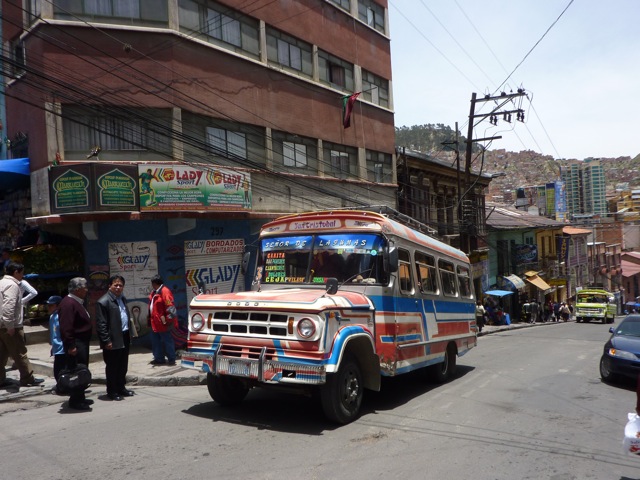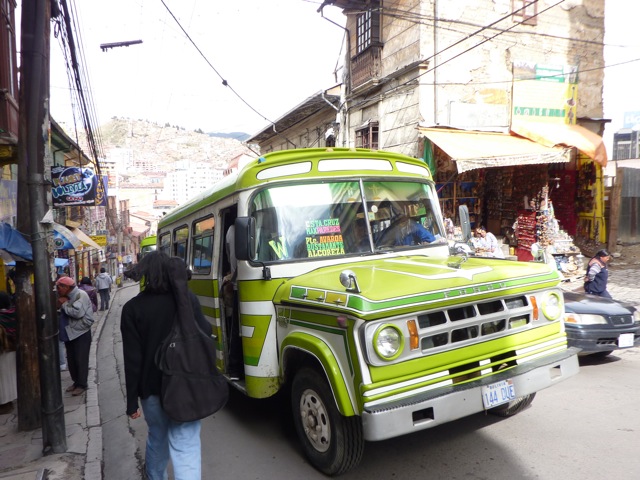La Paz, Bolivia
After another 2 hours of riding through the rain, I eventually arrived at the top of a mountain and through the clouds, I was afforded a view of La Paz, the highest capital city in the world, laid out beneath me like a collection of Lego buildings. LA PAZ
After another 2 hours of riding through the rain, I eventually arrived at the top of a mountain and through the clouds, I was afforded a view of La Paz, the highest capital city in the world, laid out beneath me like a collection of Lego buildings.

Looking down on La Paz
Here in La Paz, the rich lived in the lowest areas of the city, at around 3,660m, while the poorer were forced further up the hillsides, in a complete reversal of almost every other city in the world. The lower the land, the higher the price, and the more plentiful the air.
I descended into the city, into the streets filled with black fumes belched out by brightly coloured ex US school buses, mini vans, collectivos, pick up trucks and 4x4s. There didnt seem to be any rules of the road, except that one was well advised to give way to bigger vehicles, in my case, that meant pretty much all but the hundreds of 125cc bikes that were crazily zig-zagging their way through the dense traffic.

Fortunately, I spotted the hostel that I had pre booked the day before on the left hand side of the road, and was able to make a slightly illegal but perfectly acceptable U turn to park outside.
The second thing I noticed about La Paz, after the anarchic driving habits of the locals, was how much the altitude affected me. The reception of the hostel was up 2 flights of stairs, and by the time I reached the top, I was exhausted and struggling to catch my breath. I registered, wrestled to get my waterproof gloves off, leaving half of the inners still stuck to my hands, and peeling off the remainder of the outers, and slung my jacket and helmet over the edge of my bunk, before returning to the bike to park up and unload.
Once again, I huffed and puffed my way to the top of the stairs, where I had to stop to catch my breath before continuing down the hallway my dorm.
I sat on my bed, leaned backwards, and slept.
I awoke to the sweet, subtle sounds, of drunken adolescent Americans singing in the hallway. I looked at my wrist to determine the time, and then remembered that my watch had been stolen in Peru-things to do in La Paz No1, buy a watch.
I rolled out of bed and into the lounge area of the hostel to find a selection of bodies strewn across the floor in varying stages of decay. Those that were still able to talk were reminiscing about the events of the evening passed, who was first on the dance floor, who was first to vomit, and who was first to loose control of their jaw. It would appear that these young lads had had their first experience of Bolivias finest. I struck up a conversation with a young lad who was either going for a dread-lock look,or who had fallen over in a pile of vomit, I wasnt sure which.
He excitedly told me how he and his fellow travellers thought Bolivia was so much better than Colombia, mainly because they had found a bar where you could order a drink and a wrap of coke from the barman.
I hoped that this wasnt why everyone was so excited to come to La Paz.
I pored myself a glass of water, turned around and returned to my dorm to settle in for the night. As a cautionary measure, I squeezed my earplugs in as tightly as I could, rolled over and drifted off to sleep.
I spent the next day lazily roaming around the historical centre of La Paz. Bright colours where everywhere.

Women and children wore brightly coloured skirts and woven cardigans, the fruit stalls were ablaze with colour, and the ex-school busses showed off their paintjobs under layers of wax.



I strolled up to the Witches market, a selection of small shops, crammed to the roves with animal skulls, bones and skeletons, lotions, potions, broths and powders.

Lama Skeletons outside a shop in the Witches Market, La Paz
On shelves outside these tiny overstuffed shops where Tupperware boxes filled with beans, beads, stalks, roots and more powders, as well as small wooden carvings to ward off evil spirits and bring good fortune to the owners.



There were plastic pigs, dressed in bright waistcoats, pink plastic bags full of God-knows-what, jars of jelly like substances, ribbons and lengths of cloth with bells or bones or both attached, charms and pendants of all shapes and sizes, all for a specific reason, cure, cause or celebration.
The shopkeepers, invariably wouldnt even let me in, knowing full well that I was there to browse and would most likely not purchase anything from their store. In honesty, I think that they would prefer not to sell any of their stock to a western non-believer who was looking more for a souvenir than for a saviour.
One sight that perplexed me more than anything where the groups of young men wearing full, black balaclavas. I first spotted a group of them eating together in the market. I glanced over, but when my gaze was returned by a pair of eyes peering from the slot in the hood, I looked away and carried on walking. The next group I spotted were sat together in a semi-circle, perched on top of wooden boxes. As I looked on, an elderly gent, smartly dressed in fresh pressed trousers and jacket approached, started talking to one of the balaclava clad youths, then swapped places with the youth to sit on top of the box.
From under the box, the youth, looking remarkably like a young terrorist, retrieved a plastic bag from which he removed a selection of small round tins and brushes, and then set about polishing the older gents shoes. So, that was it, not international espionage, or hard line Muslim sympathisers, just shoe shine boys with a very odd uniform.

The Ninja ShoeShine Boys of La Paz
It seemed that on every corner in La Paz, there were groups of ninja shoe shine boys plying their trade. I never did find out why they all decided to look so scary!
I went back to the hostel for a little nap, the altitude once again getting the better of me and slept for the best part of the afternoon, and spent the evening watching movies with the young Americans who were still recovering from their night out the previous day.
The hostel had its own micro brewery on site, and included in the price of a dorm bed was a free beer , so armed with my voucher, I made my way up to the bar , to meet some more of my fellow travellers. Unfortunately there was very little variety in the hostel, 99% of the guests being young Americans intent on doing only 2 things in Bolivia. Riding down the Death Road on a rented Mountain bike, and getting wasted on cheap Cocaine.
Death Road, Camino de las Yungas to give its proper title, is a 61 km length of road that runs from La Paz to Coroico, descending from a height of 4,650m ( 15,260ft) to 1,200m(3,900ft).. It gets its name from the excessive amounts of deaths that occurred on it. It is unpaved, narrow, with blind corners. The real danger, however lies not with the road, but with the trucks barrelling down it at breakneck speeds. Sometimes you drive on the left, and sometimes on the right, the road is barely wide enough for two cars to pass each other in places, and with sheer drops on one side and a mountain on the other, there is no room for mistakes.
Neither of these options particularly appealed to me, and I was on my way back down to the living room to have a read through my guidebook, when I bumped into a French couple who were also motorcycling their way through South America.
I turned around and went back up to the bar with them, they too were going to ride the death road, but I explained that I got enough of an adrenalin rush avoiding trucks and buses on regular roads, and didnt feel I needed to go out of my way to look for more hardships than I already had to deal with. The fact that these two were riding much lighter, off road bikes made it a lot easier for them to complete their task, and when they asked me what I was riding, they were shocked that I had even managed to get the Harley as far as I had.
We sunk a few more beers together, and then the conversation turned to food. We were all fed up of rice and beans, and as we were talking a couple of lads came up to us and mentioned that we should try the Indian restaurant a few blocks away. The French, being French, had bought food to cook, me, being me, was totally unable to cook, so I wished the French luck on the Death Road and headed out in search of the Curry house.
After a few wrong turns I came across the Indian restaurant, and my eyes lit up as I read the specials menu;
Mulligatawny soup, followed by Chicken Korma, rice and Naan bread. If I had to make up my favourite three dishes in curry house, these would be the three. I was made up.
I went in, ordered my set meal, and a Cobra beer with which to wash it all down , and was not disappointed by my meal. It was delicious. The smells form my plate transported me back home to many a night with friends, passing plates of curry around in the less salubrious Brick lane restaurants in Londons East end.
It was a taste of home, a good old English Indian curry, lovely.
With a belly full of curry and beer, I walked back to the hostel, ready to leave the next day for Oruro.
